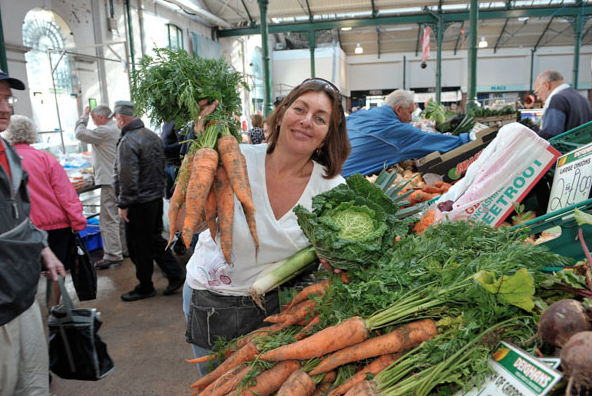Creating Community, One Market at a Time
by Amy Curtis | February 28, 2012

Inscribed above the entrance to St. George’s Market in Belfast, Ireland, are the words: Pro Tanto Quid Retribuamus, Latin for “What shall we give in return for so much?”
As I wander through the market’s eclectic stalls and shops, I feast on local delicacies, debate whether to buy watercolor postcards of the Northern Irish coast, and ruminate on the role of local markets in the community. How does Belfast, a city historically riddled with violence and sectarian strife, benefit from such a lively and inclusive public space? How can markets give back to communities?
St. George’s Market opened in 1896 and has offered its visitors food and crafts almost continuously ever since, taking a small hiatus during World War II to become a makeshift mortuary. In addition to serving the food needs of the Belfast community, the market operates as a music venue, a space for charitable events, and a place for exhibitions and installations. It was recently voted one of the best markets in the United Kingdom, glorified for its vivacity, color, versatility, and ability to foster community. It’s a meeting place for the diverse inhabitants of the city to meet and shop as equals.
While situated in the Catholic section of Belfast, St. George’s attracts Protestants and Catholics alike along with legions of ethnic minorities. Despite the ebb and flow of tensions in the city's streets, the market has been a safe haven for the public to gather, showcasing how communal desires can overcome divergent beliefs.
Local markets are slightly chaotic places, bustling with busy shoppers and boisterous vendors. But beyond the crates bursting with apples and cases containing fresh cuts of veal, markets serve a vital community role. They connect urban and rural economies, keep money in local neighborhoods, provide access to organic and sustainable food, promote public health, rejuvenate downtowns, and give cities a place for all ethnicities and socioeconomic groups to gather.
When St. George’s Market needed an economic boost in the early 1990s, the community rallied and raised 3 million pounds for refurbishments. In a city as historically divided as Belfast, St. George’s offers hope for peace and unity. In the current worldwide economic recession, a market’s role in reviving depreciated and derelict communities has never been more imperative.
Markets serve a variety of functions. But as author D.H. Lawrence wrote in his essay Mornings in Mexico, a market’s chief function must be as a “Babel and a hubbub,” a place “to buy and to sell but above all to commingle.”
As I finally decide to splurge on an Irish-inspired watercolor print, I look around the frenzied activity of St. George’s. I’m far from home but feel an undeniable sense of place.
In this video, see why St. George's Market attracts visitors from across Belfast, young and old alike:
Other Interesting Market-related Links:
Remarkable U.S. market anniversaries
Amy Curtis is a student at the University of Virginia in Charlottesville and an intern at New Dream. She is currently studying abroad at the National University of Ireland at Galway.

